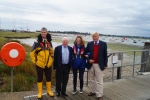Below is a response from Ian McAulay, CEO of Southern Water, following Gillian writing to him regarding reports of sewage on the water's surface,
Immediate Investigation
Following the reports around Hayling Island at the start of October, we have instructed an independent environmental assessor, Adler & Allan, to investigate the reported issues in the area, which include Langstone and Chichester Harbours. The team from Adler & Allen have attended the location to complete observational walkovers of the areas highlighted in the map below in orange. Water samples have been taken from the areas shown with the red markers and are up and downstream of two key Southern Water assets in the area. Their preliminary findings found no evidence of sewage at any point of the assessment. However, there was an accumulation of solid material and pieces of vegetation, blown into and contained within this narrow section of the harbour, by the wind. There was no foul odour or discolouration of the water noted. The water samples have been taken to a laboratory for testing and we will share the results as soon as they become available.
Reducing CSOs
Reducing the use of storm overflows is a complex task which requires a multisector coordinated approach to address the root cause of the issue which is the ingress of rain water during storm events. During times of heavy rainfall the rainwater can overwhelm the sewage system and require the need for Combined Storm Overflow (CSO) discharges, which are used to prevent flooding to homes, hospitals, schools and businesses. We believe that the most effective and environmentally considerate approach is through the separation of surface water and absorption back into the environment, which will reduce the volume of rainwater entering the sewer system. Simply building more storm capacity with new and larger assets is only part of the solution to address future climate scenarios, including increased storm frequency. The installation of large underground concrete structures and the associated treatment capacity also carries an environmental impact in terms of the materials needed to construct them and the carbon footprint in delivering and operating them. Although CSO’s are part of the design of the sewerage system in the UK, we entirely accept that this is out of step with the expectation from our customers and stakeholders. We fully support the revised Environmental Bill and welcome the opportunity to accelerate improvements beyond our current regulatory obligations. As a result we have set up a dedicated CSO task force, led by Dr Nick Mills, with the aim to reduce storm discharges by 80% by 2030. In the short term (next two years) we plan to demonstrate at scale how this will be achieved in a number of catchments across our region. We will publish more information on these plans and would be happy to talk with you further about these projects and other activities.
Beachbuoy provides near real time information about CSO activity at designated bathing waters and recreational watercourses. This is a significant part of our commitment to greater openness and transparency and we welcome the influence that is having on the public debate about CSOs. We lead the sector in making this information available to the public in near-real time.
All 83 of our bathing waters meet strict European standards. 58 of our bathing waters are graded excellent, 21 are good and 4 are sufficient. None are graded as poor. None of our bathing waters would have met sufficient status 20 years ago.
We are spending £22.5m by 2025 to target those beaches where we can make further improvements to water quality, for example by targeting misconnections and enhancing our storm storage.


